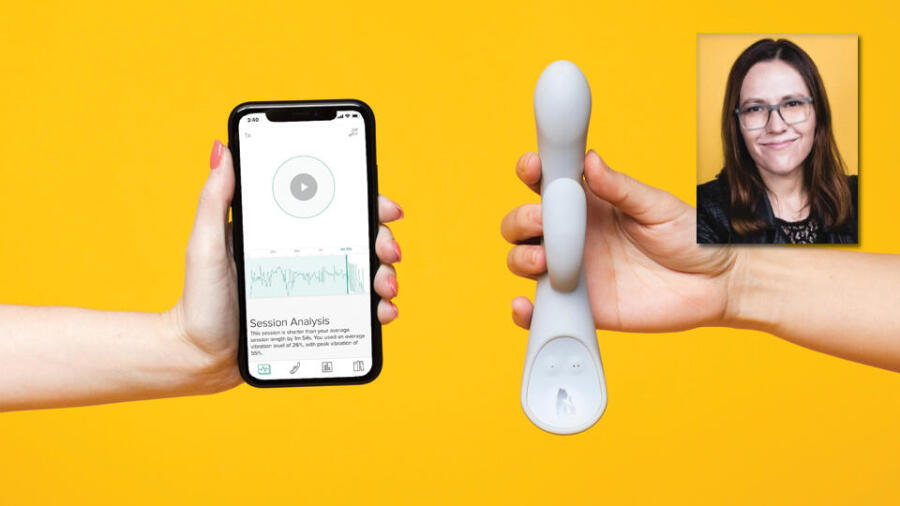There’s the old saying that the adult industry helped shape the internet. While that may be true for pornography, the saying doesn’t hold true for the pleasure product industry.
Most of the recent introductions in the pleasure product space have been design-related — namely smaller, clitoral suction products and the return of devices that produce different motions besides vibration from a vibration motor to mimic different motions and sensations.
This is just the beginning of the technology revolution (for pleasure products).
The focus makes sense, given that most of the companies in the industry specialize in mass manufacturing or white-labeling for physical products. There is consumer demand for new and novel experiences and we can use different designs, physical sensations, and product branding/marketing to provide it.
Still, it’s interesting to note that the pleasure product industry is one of the rare industries that has been minimally touched by modern software and technological advances in the 21st century, especially considering so many other devices in our lives have been enhanced by technology of varying complexity. Smart phones, watches, home devices, consumer health devices, and so on use all sorts of sensors, multilayer boards, software and data to provide a huge variety of experiences versus their analogue counterparts.
Meanwhile, in the pleasure product space, any “smart” sex product is synonymous with remote-controlled toys. The same goes for the terms app-controlled and Bluetooth-enabled. While remote-controlled products can be great toys for long-distance relationships, in-person play and camming, internet-controlled products have been in the marketplace for nearly 20 years now and are just a tiny slice of what technology can do to add value to a user’s experience and expand the pleasure product industry at-large.
Before I go on, yes, there is also VR, though VR is still a fairly niche category, and like remote-control capabilities, has existed as a technology for decades. For this article, I’m focusing on technology and experiences that have become more possible to create for consumers in the last 20 years.
Examples in other industries
In our lifetimes, technology has seeped into all aspects of our lives.
Take Peloton, the internet-connected exercise company. They had their IPO last year at an $8 billion valuation with just two products: a bike and a treadmill. On the face of it, their bike and treadmill look no different than a typical bike or treadmill. It has many of the same parts as a bike or treadmill, works the same way, and looks the same.
What makes Peloton different from other exercise equipment companies is the experiences behind what it provides. By adding technology to what looks like a typical exercise machine, the Peloton transforms from just an exercise machine to a tracker, a supportive community that encourages you to keep going, and an outlet to the outside world. You can take live classes led by instructors, track your progress over time, earn badges for streaks or participating in special events, and compete with friends and strangers. These are features and experiences that you wouldn’t get from a typical bike or treadmill.
What makes Peloton different is that they’re selling experiences on platforms through the means of exercise bikes and treadmills. They wouldn’t be able to do that by just having an app with classes, and the hardware by itself wouldn’t be able to create those experiences only engineered through software. It only works by combining the two together.
Looking at other high-tech products like Apple (phones and watches), Alexa (home devices), FreeStyle Libre (continuous glucose monitoring), and many others, you’ll see that these companies have all used different types of modern technology to enhance an experience or to make an experience possible for customers that would have been unimaginable with their more analogue counterparts. They’ve opened up new markets and new demographics interested in “high-tech products.”
There’s often an implicit or explicit assumption that younger generations are the only ones who engage with new technology. That may be true for social media platforms like TikTok, but many of the aforementioned technology-enhanced products particularly resonate with older individuals. Alexa and other home devices have helped many elderly people live more independently and comfortably than before, just as they’ve helped nerds like me adjust the lights to dim down automatically in the evening so it’s easier to fall asleep and get precious REM sleep.
Why there is a lack of high-tech products in the pleasure product industry?
Based on my experience in the space for nearly a decade now, I believe there are a few reasons why there has been a lack of technology in the pleasure product space.
1. I hinted at this in the beginning — the core expertise of many manufacturers is physical product manufacturing. This is not necessarily a bad thing (after all, we need physical devices to produce different sensations), but unlike other industries, there have been few teams and companies that have embraced modern technology.
2. There is a lack of knowledge of how to oversee engineering teams. High-tech product companies hire full-time teams dedicated to different areas of a technical stack to produce a lot of in-house technology to support high-tech products. Think software (frontend and backend), hardware, sensors, AI and more. Those are all different specialties and most engineers have one or two focuses. There are very few who are generalists. It takes some technical understanding and expertise to oversee teams like this, which most of the pleasure product space doesn’t have.
3. R&D is expensive. For many companies, if the dildo factory is working, why change it? Why throw your money into hiring expensive technologists to create some fanciful technology you may not understand and may not know will succeed? It’s a risky endeavor, and for companies that already have to navigate the murkiness of advertising pleasure products, it’s hard to be onboard with doing something new in favor of putting your money into something that works fine (for now).
4. There’s a lack of understanding of what technology could do to expand or enhance experiences in the pleasure product space. For example, one of the most common questions we’ve gotten about Lioness from people who don’t quite understand what it is, is why would people want data on their sex life?
Admittedly, this was a question we had too when we saw people take interest in the data (it wasn’t our original aim when developing Lioness). People are curious to learn more about themselves, especially on a topic that is hard to get good information on, especially personalized information about your own pleasure. Data helps re-contextualize a topic that may be difficult to talk about, painful, or taboo for individuals and couples. We’ve seen people experiment with different ways to use our product because they’re curious how their data and experience would change. Sometimes these changes are inadvertent — the most perplexing we’ve seen was when someone tracked the severity of her concussion (and then recovery) with her orgasm data.
It’s usually not helpful to add technology to something for technology’s sake. But don’t discount the ability for technology to add something unique and needed for a large segment of customers. It might not be something you’d expect, but when you see it resonating with people, learn why — you might be surprised and learn something new!
5. Retail training for new types of devices is difficult. When we first launched Lioness, we thought we would be able to have some sort of tablet display next to it so that people could experiment with the Live View and see the corresponding data with the app. While that may be true for a product in Best Buy, that hasn’t been the case with most pleasure product retailers. By not having a software demo, we aren’t able to show a core part of our product that differentiates it from the rest, and it hurts both the retailer and us.
Other tech-enabled products in other industries have faced similar challenges, and in most cases, companies create their own retail channel with dedicated staff trained to show and talk about these new tech-enabled products. Peloton, Apple, Tesla and Amazon all have done this. In our case, it’s hard to train retail staff from different stores about a product that does something completely different than the other products in their store and is often more expensive than comparable products.
This is just the beginning of the technology revolution (for pleasure products).
There are many ways technology can provide new experiences and profit in the pleasure product industry. It may take some time for these products to enter the mainstream or appear in your local pleasure shop, but just because it’s not there right now doesn’t mean it will never be. It takes time for people to learn and adopt new things, and sometimes new things don’t enter the market in the same ways other products did before them. I hope this can give some perspective, new ideas, and excitement for what is possible in our industry.
Liz Klinger is the CEO and co-founder of Lioness, a women-led company and a recognized pioneer and innovator in the sextech and femtech industries.








